Examination of the Coordination and Impediments of Rural Socio-Economic-Spatial Coupling in Western Hunan from the Standpoint of Sustainable Development
Abstract
1. Introduction
2. Study Area and Methodology
2.1. Study Area
2.2. Data Source
2.3. Research Methodology
2.3.1. Development of the Socio-Economic-Spatial Coupling Evaluation Index System
2.3.2. Determination of Indicator Weights
2.3.3. Coupled Coordination Degree Model
2.3.4. Spatial Markov Chain Model
2.3.5. Obstacle Degree Model
3. Results
3.1. Spatio-Temporal Analysis of Socio-Economic-Spatial Development Levels
3.1.1. Temporal Evolutionary Features
3.1.2. Spatial Evolution Characteristics
3.2. Analysis of Socio-Economic-Spatial Coupling Degree and Coupling Coordination Degree
3.2.1. Reconfiguration Analysis
3.2.2. Coupling Analysis
3.2.3. Coupled Coordination Degree Space Markov Chain Analysis
3.2.4. Multiple Stepwise Regression Analysis
3.3. Analysis of the Degree of Coupled Socio-Economic-Spatial Barriers
3.3.1. Analysis of Barrier Factors at the Normative Level
3.3.2. Analysis of Indicator Layer Barriers
4. Discussion
5. Conclusions
Author Contributions
Funding
Institutional Review Board Statement
Informed Consent Statement
Data Availability Statement
Conflicts of Interest
References
- Shao, C.F.; Zhan, X.S.; Chen, S.H. Evaluation index system of rural sustainable development based on SDGs. China Popul. Resour. Environ. 2023, 33, 21–31. [Google Scholar] [CrossRef]
- Yan, S.M.; Wen, J.; Growe, A.; Wand, A. Rural Strategy Transferring and Policy Making Towards Sustainable Development Goals: Taking the European Countries as Examples. Urban Plan. Int. 2024, 39, 10–23+41. [Google Scholar] [CrossRef]
- Lu, T.H.; Yu, T. Reconstruction of rural social space in tourist destinations based on social network analysis: A case study of Shiwa Beautiful village, Nanjing city. Sci. Geogr. Sinica. 2020, 40, 1522–1531. [Google Scholar] [CrossRef]
- Tu, S.S.; Zheng, Y.H.; Long, H.L.; Wan, S.M.; Liang, X.L.; Wang, W. Spatio-temporal pattern of rural development and restructuring and regional path of rural vitalization in Guangxi, China. Geogr. Res. 2020, 75, 365–381. [Google Scholar] [CrossRef]
- Yu, B.; Li, Y.Y.; Zhu, Y.Y.; Zhuo, R.R.; Zeng, J.X. Characteristics and regional model of rural restructuring in main agricultural production regions in Central China:A case study of Jianghan Plain. J. Nat. Resour. 2020, 35, 2063–2078. [Google Scholar] [CrossRef]
- Hu, S.; Yu, B.; Wang, M. Rural restructuring and transformation: Western experience and its enlightenment to China. Geogr. Res. 2019, 38, 2833–2845. [Google Scholar] [CrossRef]
- Long, H.L.; Tu, S.S. Theoretical thinking of rural restructuring. Prog. Geogr. 2018, 37, 581–590. [Google Scholar] [CrossRef]
- Zou, Y.N.; Cheng, Q.P.; Ren, Y.T.; Jin, H.Y. Analysis of water-food-energy-ecological-environment coupling coordination and influencing factors at Lincang City of Yunnan Province based on sustainable development goals. Bull. Soil Water Conserv. 2023, 43, 185–195. [Google Scholar] [CrossRef]
- He, S.K.; Shuai, X.Y. Research on empowering coordinated development of “water resources-social economy” inYangtze River Economic Belt through environmental regulation. Yangtze River 2024, 55, 44–50. [Google Scholar] [CrossRef]
- Hao, Z.J.; Wen, Q.; Shi, L.N.; Wu, X.Y.; Ding, J.M. Spatial Network Analysis of Coupling Coordination Between Social Economy and Eco-Environment in Yellow River Basin Urban Agglomerations. Econ. Geogr. 2023, 43, 181–191. [Google Scholar] [CrossRef]
- Zhai, Y.K.; Li, Y.L.; Shen, H.O.; Che, X.C. Spatial autocorrelation patterns and influencing factors of soil and water loss and socio-economic development in Jilin Province. Bull. Soil Water Conserv. 2024, 44, 144–151. [Google Scholar]
- Li, K.K.; Zhou, Z.H.; Wang, Z. Analyzing socio-economic spatial factors driving soil erosion in China based on multi-scale geographically weighted regression model. J. Huazhong Agric. Univ. 2024, 43, 29–38. [Google Scholar] [CrossRef]
- Gao, H.J.; Han, H.Q.; Yu, H.Y.; Han, M.R. Spatial Correlation of Socideconomic Factors and Ecosystem Service Values in Guizhou Province. Res. Soil Water Conserv. 2016, 23, 262–266. [Google Scholar] [CrossRef]
- Jiang, X.J.; Wang, Y.J.; Chen, X.P.; Zhang, Z.L. Temporal and Spatial Evolution Analysis of the Coupling and Coordination Among Population, Economy, Space, and Urbanization. J. Lanzhou Univ. Soc. Sci. 2015, 43, 63–71. [Google Scholar] [CrossRef]
- Jin, M.J. Coupling Coordination Analysis of Population-Economy-Space-Social Urbanization in Shanxi Province. Sci. Technol. Manag. Land Resour. 2018, 35, 107–115. [Google Scholar]
- Wang, H.; Wang, C.X. Study on the coordinated development of economy-population-society-space urbanization in central China: Taking Hubei province as an example. Hubei Agric. Sci. 2019, 58, 137–141. [Google Scholar] [CrossRef]
- Li, H.J.; Qu, J.S.; Pang, J.X.; Xu, L.; Han, J.Y. Spatial-temporal synthetic measurement of coupling coordination and sustainable development of population-economy-society-resource environment system in Gansu Province. Arid. Land Geogr. 2020, 43, 1622–1634. [Google Scholar]
- Jiang, Z.Y.; Zhou, J.W.; Zhao, Y. Study on the Time and Space Coupling and Coordination Relationship of Agricultural Economy-Society-Ecological Modernzation in Central China Under the Background of Rural Revitalization. Chin. J. Agric. Resour. Reg. Plan. 2021, 42, 99–108. [Google Scholar]
- Liu, Z.W.; Zheng, Y.; Li, Z.H.; Zhang, S.Q.; Yang, H.; Sang, X.F. Evaluation on water resources-economy-population matching degree from perspectiveof spatial equilibrium. Yangtze River 2023, 54, 31–39. [Google Scholar] [CrossRef]
- Cui, J.; Li, X.T.; Chu, N.C. Coordination Research of High-Speed Rail Accessibility and Economic-Social Development Level in Less Developed Areas. Econ. Geogr. 2020, 40, 43–51. [Google Scholar] [CrossRef]
- Yu, R.L.; Liu, C.L.; Xiong, J.P.; Zeng, J.X. The Coupling Evolvement of ERE Composite System on Wuhan Metropolitan Area. Econ. Geogr. 2012, 32, 120–126. [Google Scholar] [CrossRef]
- Jiang, L.; Zhou, H.F.; Bai, L. Spatial Differences in Coupling Degrees of Economy, Urbanization, Social Security and Eco-environment in the Middle Reaches of Yangtze River. Resour. Environ. Yangtze Basin 2017, 26, 649–656. [Google Scholar]
- Zheng, Y.F. Evaluation and Spatial Characteristics of the Economic and Social-Development in the Three Gorges Reservoir Area in Chongqing. J. Yangtze Norm. Univ. 2021, 37, 11–21. [Google Scholar] [CrossRef]
- Wei, F.W.; Huang, J.; Zhu, H.F. The correlation analysis for the coupling coordinative degree of tourism-economic-ecological environment on provincial region—Take Guangxi as an example. J. Northwest Norm. Univ. Nat. Sci. 2017, 53, 116–123. [Google Scholar] [CrossRef]
- Deng, P.; Chen, J.; Chen, D.; Shi, H.Y.; Bi, B.; Liu, Z.; Yin, Y.; Cao, X.C. The evolutionary characteristics analysis of the coupling and coordination among water, energy and food:take Jiangsu Province as an example. J. Water Resour. Water Eng. 2017, 28, 232–238. [Google Scholar] [CrossRef]
- Zhong, Q.K.; Fu, H.P.; Yan, J.L.; Zhe, L. How does energy utilization affect rural sustainability development in traditional villages? Re-examination from the coupling coordination degree of atmosphere-ecology-socioeconomics system. Build. Environ. 2024, 257, 111541. [Google Scholar] [CrossRef]
- Zhao, Y.; Guan, H.; Wang, S.; Yang, Z.; Li, Z.; Sun, Y. Measurement of Urban and Rural Resilience and Their Coupling Coordination Relationship in Northeast China. Chin. Geogr. Sci. 2025, 35, 612–630. [Google Scholar] [CrossRef]
- Yang, Q.; Tian, X.; Wang, H.; Tan, T. Exploration of the coupling coordination between rural tourism development and agricultural eco-efficiency in islands: A case study of Hainan Island in China. J. Nat. Conserv. 2025, 84, 126822. [Google Scholar] [CrossRef]
- Chen, X.L.; Zhu, S.Y.; Kong, X.S.; Chen, C.F. Dynamic and Static Characteristics of Spatiotemporal Coupling among Rural Population, Land, and Industry in Hubei Province. Chin. J. Agric. Resour. Reg. Plan. 2021, 42, 31–38. [Google Scholar]
- Cheng, M.Y.; Liu, Y.S.; Jiang, N. Study on the spatial pattern and mechanism of rural population land-industry coordinating development in Huang-Huai-Hai Area. Acta Geogr. Sin. 2019, 74, 1576–1589. [Google Scholar] [CrossRef]
- Mateusz, T. Evaluation of coupling coordination degree and convergence behaviour of local development: A spatiotemporal analysis of all Polish municipalities over the period 2003–2019. Sustain. Cities Soc. 2021, 71, 102992. [Google Scholar] [CrossRef]
- Muhadaisi, A.; Zhang, F.; Liu, K.; Fang, C.L.; Kung, H.T. Coupling coordination analysis of urbanization and eco-environment in Yanqi Basin based on multi-source remote sensing data. Ecol. Indic. 2020, 114, 106331. [Google Scholar] [CrossRef]
- Waseem, M.N.; Shahfahad; Swapan, T.; Ishtiaq, M.; Atiqur, R. Modelling built-up land expansion probability using the integrated fuzzy logic and coupling coordination degree model. J. Environ. Manag. 2022, 325 Pt A, 116441. [Google Scholar] [CrossRef] [PubMed]
- Gupta, P.; Kolhe, P.N.; Vyas, S. Coupling and coordination association between night light intensity and women safety—A comparative assessment of Indian metropolitan cities. J. Clean. Prod. 2024, 481, 144135. [Google Scholar] [CrossRef]
- Kwilinski, A.; Lyulyov, O.; Pimonenko, T. The Coupling and Coordination Degree of Digital Business and Digital Governance in the Context of Sustainable Development. Information 2023, 14, 651. [Google Scholar] [CrossRef]
- Ramakrishnan, V.; Ramasamy, N.; Anand, D.M.; Santhi, N. Coupling Coordination and Data Management for Additive Manufacturing Systems Based on Smart Logistics. Environ. Claims J. 2024, 36, 278–304. [Google Scholar] [CrossRef]
- Behnke, N.; Hegele, Y. Achieving cross-sectoral policy integration in multilevel structures—Loosely coupled coordination of “energy transition” in the German “Bundesrat”. Rev. Policy Res. 2023, 41, 160–183. [Google Scholar] [CrossRef]
- Motoshi, K.; Yoshiaki, T.; Takumi, W.; Toshiaki, H.; Hideo, H. Coordinated force generation of skeletal myosins in myofilaments through motor coupling. Nat. Commun. 2017, 8, 16036. [Google Scholar] [CrossRef] [PubMed]
- Nikos, A.; Ioannis, G.; Makrygiorgou, D.I.; Dimitris, S.; Christos, D.; Ioannis, M.; Athanasios, B.; Dimitrios, P. Coordinating Capacity Calculation via Electricity Market Coupling: Insights from the H2020 CROSSBOW Project. Electricity 2022, 3, 182–201. [Google Scholar] [CrossRef]
- Zhang, P.C.; Fu, Y.Y.; Lu, B.L.; Li, H.B.; Qu, Y.J.; Ibrahim, H.; Wang, J.X.; Ding, H.; Ma, S.L. Coupling Coordination Evaluation and Optimization of Water–Energy–Food System in the Yellow River Basin for Sustainable Development. Systems 2025, 13, 278. [Google Scholar] [CrossRef]
- Xu, H.; Wu, Y.Q. Measurement of the Global Inclusive Green Growth Index and Its Coupling Coordination Evaluation under the Sustainable Development Goals. Econ. Geogr. 2025, 45, 36–47. [Google Scholar] [CrossRef]
- Ye, S.; Su, A.Y.; Ge, Y.J. Economic-social-ecological coupling coordination from the perspective of sustainable societal safety: Take Qinghai Province as an example. J. Qinghai Norm. Univ. (Nat. Sci. Ed.) 2024, 40, 14–24+49. [Google Scholar] [CrossRef]
- Yin, L.; Wei, W.; Li, H.R.; Xia, J.N.; Bo, L.M. Spatio-temporal differentiation and influencing factors of territorial spatial pattern evolution in China’s land area: A comparative analysis based on the Hu Huanyong Line and the Bole-Taipei Line. Geogr. Res. 2025, 44, 552–576. [Google Scholar] [CrossRef]
- Cui, H.; Xu, G.; Yu, H. Spatio-temporal Pattern, Influencing Mechanisms and Optimization Strategies of Rural Restructuring from the Perspective of Territorial Spatial Governance: A Case of Guizhou Province. Hum. Geogr. 2023, 3, 79–91. [Google Scholar] [CrossRef]
- Zhang, Y.; Long, H.; Ge, D.; Tu, S.; Qu, Y. Spatio-temporal Characteristics and Dynamic Mechanism of Farmland Functions Evolution in the Huang-Huai-Hai Plain. Acta Geogr. Sin. 2018, 3, 518–534. [Google Scholar] [CrossRef]
- Fan, D.; Ke, H.; Cao, R. Modification and Improvement of Coupling Coordination Degree Model. Stat. Decis. 2024, 22, 41–46. [Google Scholar] [CrossRef]
- Li, Y.; Wang, J.; Liu, Y.; Long, H. Spatial Pattern and Influencing Factors of the Coordination Development of Industrialization, Informatization, Urbanization and Agricultural Modernization in China: A Prefecture Level Exploratory Spatial Data Analysis. Acta Geogr. Sin. 2014, 2, 199–212. [Google Scholar] [CrossRef]
- Yang, Q.; Zhu, H. Analysis of spatial differences and driving factors of agricultural resource allocate on efficiency in China. Stat. Decis. Mak. 2024, 40, 62–66. [Google Scholar] [CrossRef]
- Zhou, X.; Ma, Z.M.; Yin, F.; Jiang, D. Analysis and prediction about land use change in area along the Silk Road Economic Belt based on CA-Markov model: A case study of five provinces in Northwest China. J. Northwest Univ. (Nat. Sci. Ed.) 2018, 48, 291–298+305. [Google Scholar] [CrossRef]
- Li, J.L.; Pan, J.R.; Feng, F.; Xu, P.; Liu, C. Coupling coordination development of PWEE system and obstacle factors in nine provinces/regions of the Yellow River Basin. J. Water Resour. Water Eng. 2024, 35, 47–56. [Google Scholar] [CrossRef]
- Yang, Q.K.; Wang, L.; Lü, L.G.; Li, Y.; Fang, Y.T.; Zhu, G.L.; Wang, Y.X. Evaluation of Land Ecological Status and Diagnosis of Obstacle Factors in Jiangsu, China. Environ. Sci. 2024, 10, 5880–5889. [Google Scholar] [CrossRef]
- Yang, S.S.; Huang, L.L.; Duan, Z.C.; Huang, W.H. Spatiotemporal Dynamic and Obstacle Factor Analysis of Tourism Economic Resilience in Chinese Urban Agglomeration. J. Nat. Resour. 2024, 6, 1262–1277. [Google Scholar] [CrossRef]
- Du, H.J.; Deng, Q.Z.; Long, Y.H.; Zhang, Z.Q. Sustainable Utilization and Obstacle Factors of Water Resource in Jiangxi Province. Bull. Soil Water Conserv. 2023, 6, 200–208. [Google Scholar] [CrossRef]
- Chen, H.; Hua, Y.Y. Measurement, Evolution and Obstacle Factors of High-Quality Development Level of Urban-Rural Integration in the Core Area of the Yangtze River Delta. Resour. Environ. Yangtze Basin 2024, 10, 2071–2084. [Google Scholar]
- Zhao, F.F.; Yi, P.; Zhao, X.; Hu, Z. Analysis on Dynamic Mechanism and Obstacle Factors of Industrial Ecologization and Ecological Industrialization in the Three Gorges Ecological Economic Corridor of the Yangtze River. Areal Res. Dev. 2024, 4, 50–56. [Google Scholar] [CrossRef]
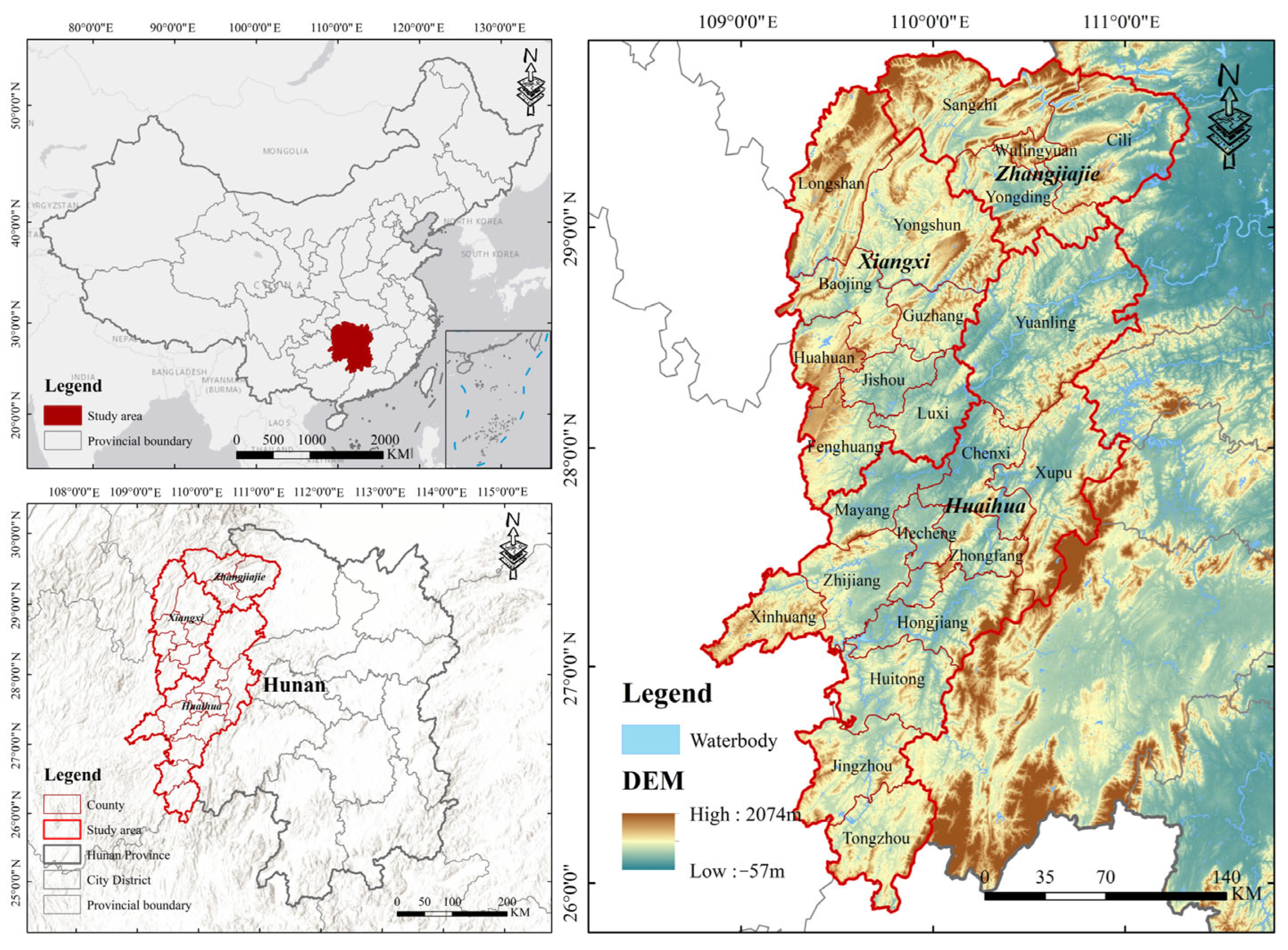
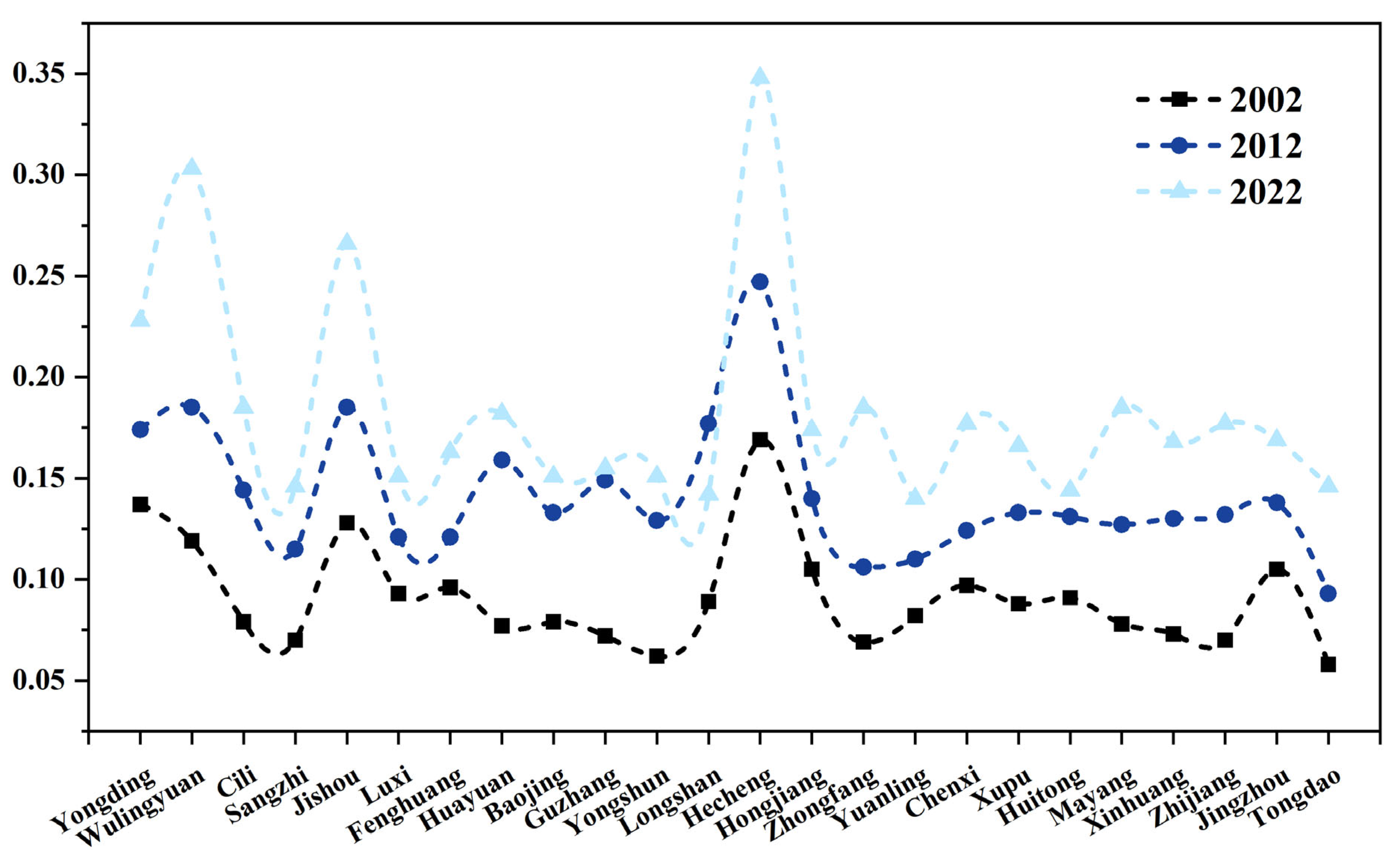
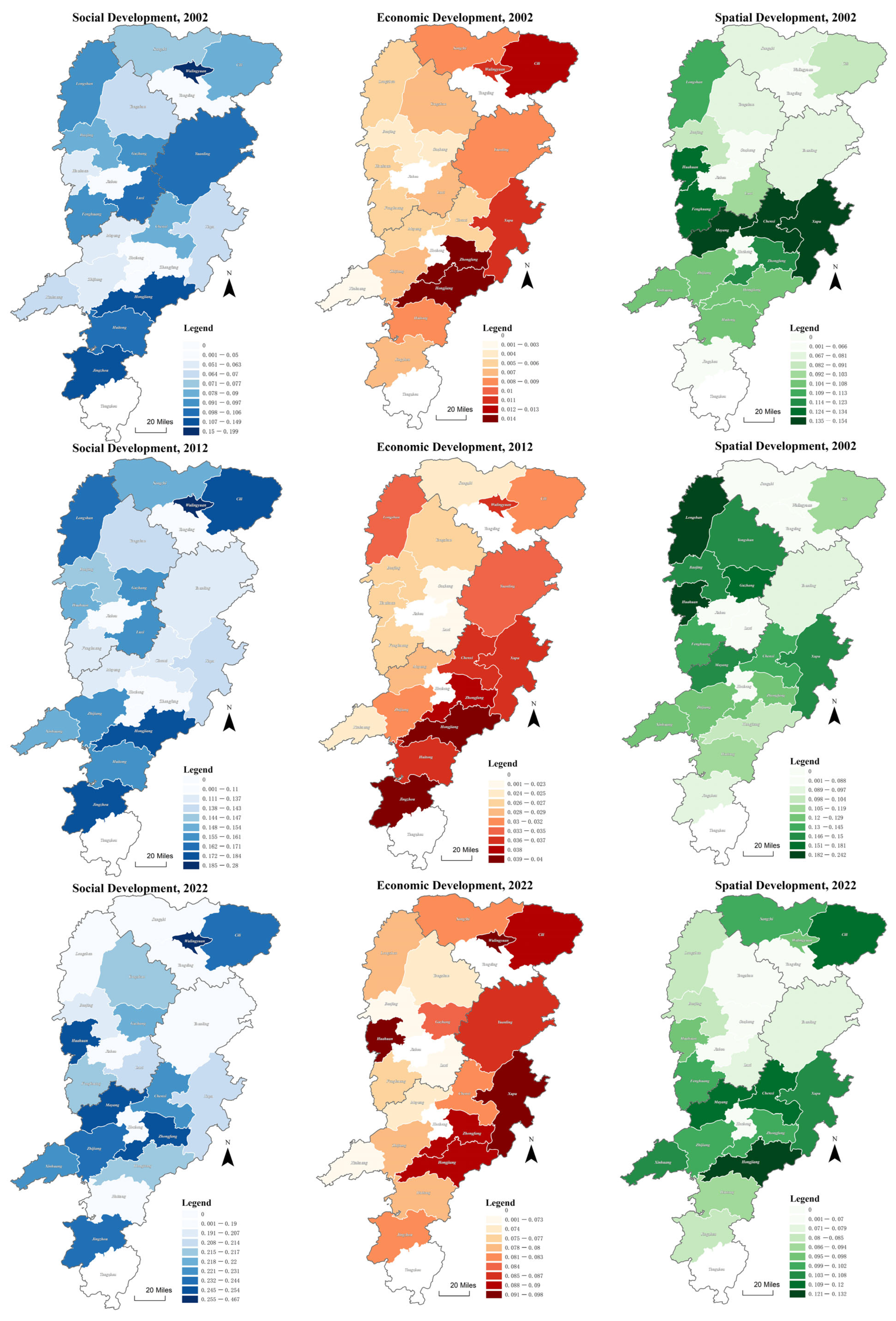


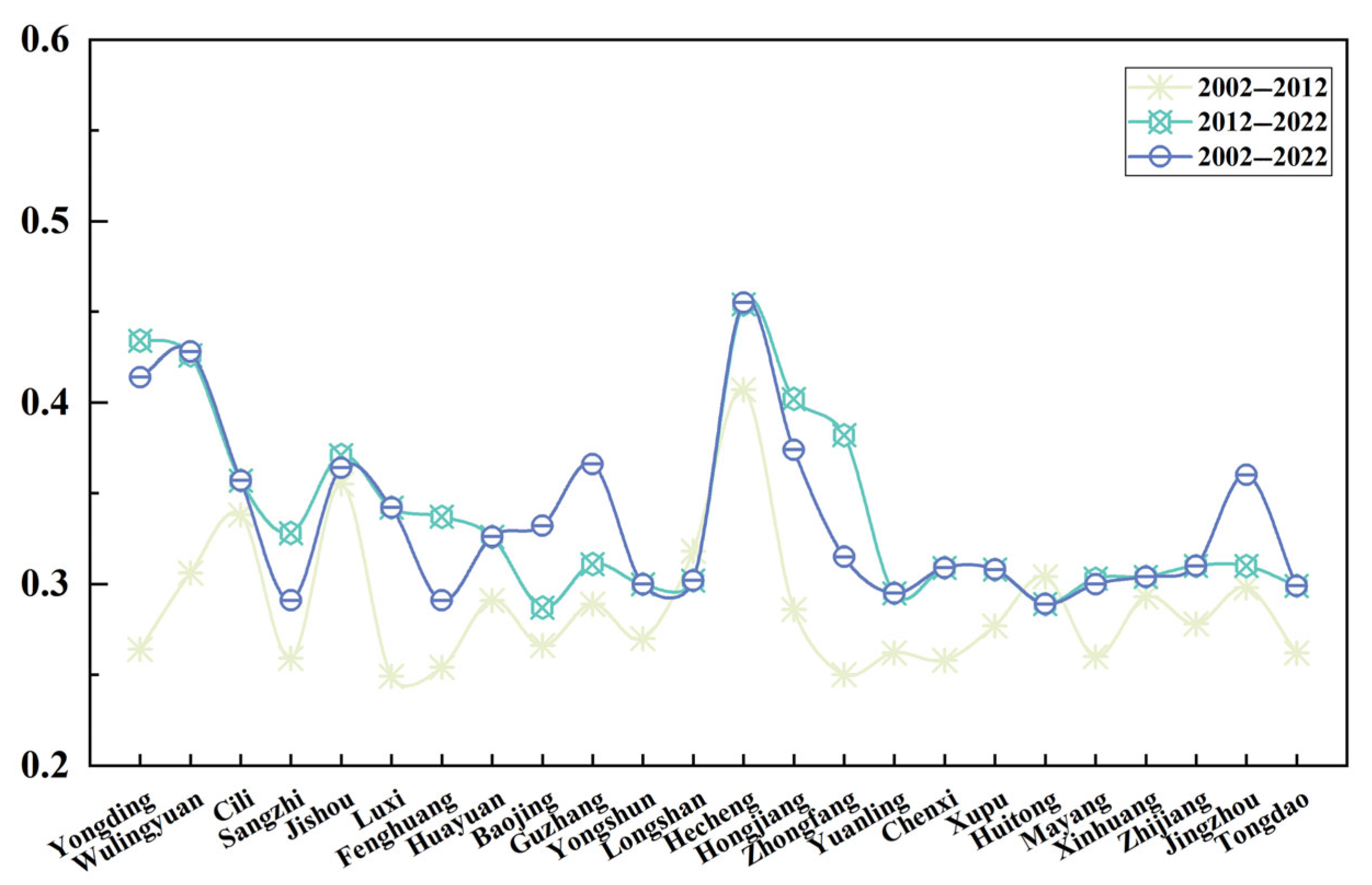

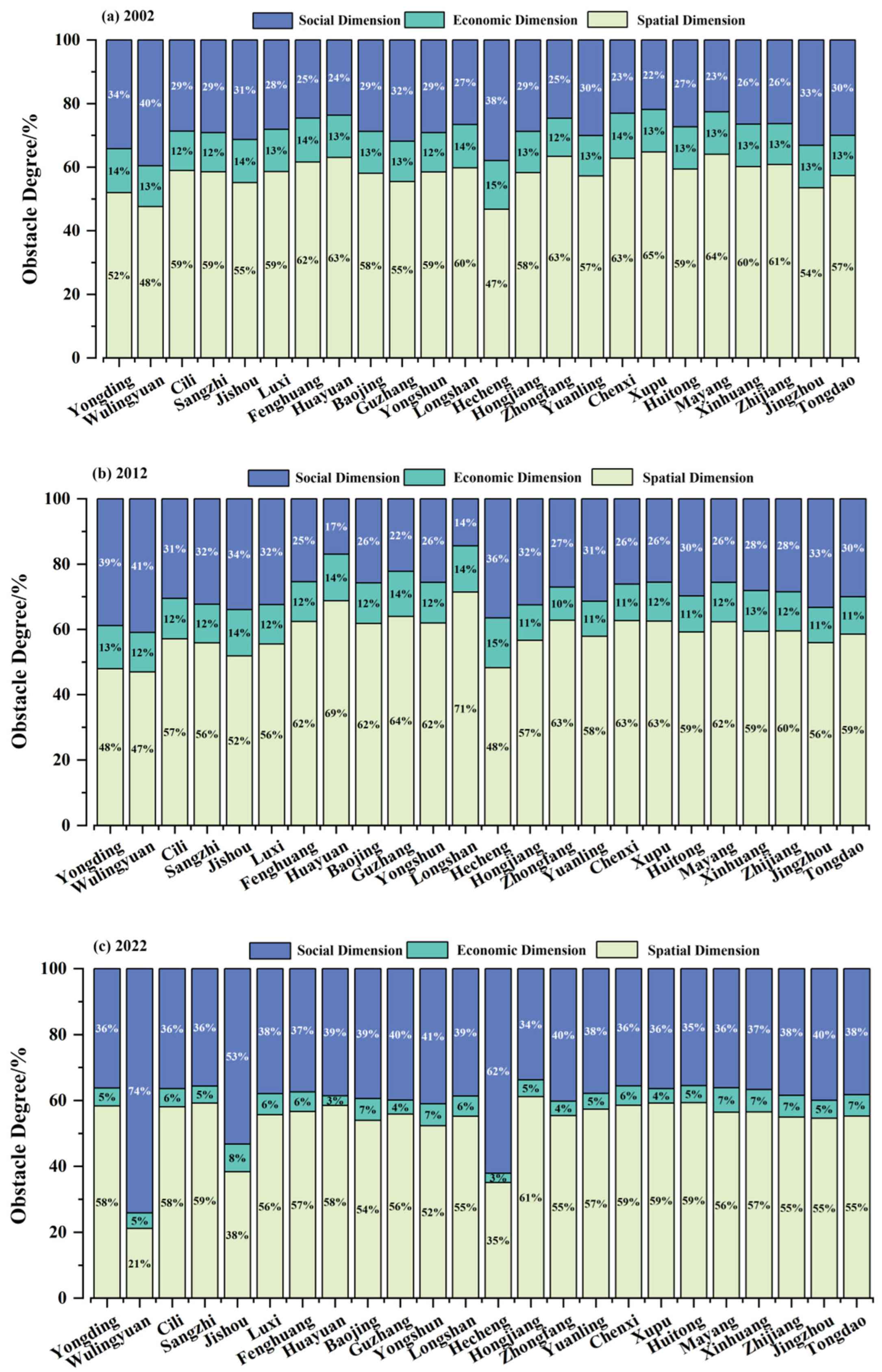

| Standardized Layer | Indicator Layer | Meaning | Calculation Method | Weights |
|---|---|---|---|---|
| Social dimension | Urbanization rate (X1) | Rural reconfiguration dominant factors | Proportion of urban population to total population | 0.2948 |
| Rural population change rate (X2) | Changes in rural population | (Final rural population—Initial rural population)/Initial rural population | 0.0780 | |
| Gross fixed investment rate (CNY million/km2) (X3) | Rural territorial infrastructure development | Total fixed investment per county area | 0.1857 | |
| Economic dimension | Gross output value of agriculture, forestry, animal husbandry and fisheries (CNY billion) (X4) | Town development attracts and drives the countryside, reflecting industrial development | Gross output value of agriculture, forestry, livestock and fisheries | 0.0133 |
| Agricultural labor productivity (CNY million per 10,000 individuals) (X5) | Agricultural economic development | Gross output of agriculture, forestry, and fisheries divided by the total work force in these sectors | 0.0057 | |
| Disposable income per capita of permanent residents in rural regions (CNY) (X6) | Income of rural inhabitants | Per capita disposable income of permanent residents in rural areas | 0.0672 | |
| Engel’s coefficient for rural inhabitants (X7) | Rural residents’ food expenditures as a percentage of total consumption expenditures | Total food expense divided by total household consumption spend, multiplied by 100 percent | 0.0357 | |
| Spatial dimension | Rate of change in cropland (X8) | Changes in land use structure, reflecting regional development trends and directions | (Final cropland area—Initial cropland area)/Initial cropland area | 0.1725 |
| Per capita rural housing area (m2) (X9) | Size of living space | Per capita housing area in villages | 0.0522 | |
| Population density in rural areas (individuals/km2) (X10) | Measuring rural population distribution | Rural population/Land area | 0.0949 |
| Time Period | Regression Equation | Significant Variable | R2 | p |
|---|---|---|---|---|
| 2002–2012 | y = 0.4806 × X1 + 0.6343 × X2 + 5.9410 × X4 + 0.4089 × X8 + 0.3707 × X10 + 0.1742 | X1, X2, X4, X8, X10 | 0.9397 | <0.05 |
| 2012–2022 | y = 0.2612 × X1 + 0.2618 × X2 + 2.6466 × X6 + 0.3170 × X8 + 0.3505 × X10 + 0.1476 | X1, X2, X6, X8, X10 | 0.9886 | |
| 2002–2022 | y = 0.2383 × X2 + 0.1971 × X3 + 2.7607 × X6 + 0.2555 × X8 + 0.1326 × X9 + 0.2034 × X10 + 0.1552 | X2, X3, X6, X8, X9, X10 | 0.9914 |
Disclaimer/Publisher’s Note: The statements, opinions and data contained in all publications are solely those of the individual author(s) and contributor(s) and not of MDPI and/or the editor(s). MDPI and/or the editor(s) disclaim responsibility for any injury to people or property resulting from any ideas, methods, instructions or products referred to in the content. |
© 2025 by the authors. Licensee MDPI, Basel, Switzerland. This article is an open access article distributed under the terms and conditions of the Creative Commons Attribution (CC BY) license (https://creativecommons.org/licenses/by/4.0/).
Share and Cite
Tang, C.; Qiu, T.; He, S.; Zhang, W.; Zeng, H.; Li, Y. Examination of the Coordination and Impediments of Rural Socio-Economic-Spatial Coupling in Western Hunan from the Standpoint of Sustainable Development. Sustainability 2025, 17, 6691. https://doi.org/10.3390/su17156691
Tang C, Qiu T, He S, Zhang W, Zeng H, Li Y. Examination of the Coordination and Impediments of Rural Socio-Economic-Spatial Coupling in Western Hunan from the Standpoint of Sustainable Development. Sustainability. 2025; 17(15):6691. https://doi.org/10.3390/su17156691
Chicago/Turabian StyleTang, Chengjun, Tian Qiu, Shaoyao He, Wei Zhang, Huizi Zeng, and Yiling Li. 2025. "Examination of the Coordination and Impediments of Rural Socio-Economic-Spatial Coupling in Western Hunan from the Standpoint of Sustainable Development" Sustainability 17, no. 15: 6691. https://doi.org/10.3390/su17156691
APA StyleTang, C., Qiu, T., He, S., Zhang, W., Zeng, H., & Li, Y. (2025). Examination of the Coordination and Impediments of Rural Socio-Economic-Spatial Coupling in Western Hunan from the Standpoint of Sustainable Development. Sustainability, 17(15), 6691. https://doi.org/10.3390/su17156691







